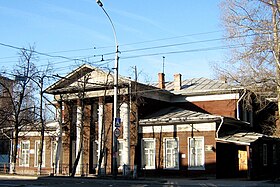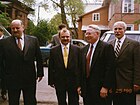Museum of the Diplomatic Corps

|
|
| Data | |
|---|---|
| place | Herzstrasse (Uliza Gerzena), 35, 160035 |
| opening | 07/16/1997 |
| Number of visitors (annually) | More than 2000 |
| management |
Alexander Vladimirovich Bykov
|
The Museum of the Diplomatic Corps ( Russian Музей дипломатического корпуса ) is a private historical museum in the Russian city of Vologda . It is located in the former private house of Pawel Pusan-Pusirewski (wooden house, monument of architecture of the first third of the 19th century). This building housed the US Embassy in 1918 . The exhibition introduces the little-known events from February to July 1918 associated with the stay of eleven foreign embassies and missions in the city.
The diplomatic corps in Vologda in 1918
From the end of February 1918, Vologda became the "diplomatic capital of Russia". Under threat of the German occupation of Saint Petersburg , representatives from 11 embassies (from the United States , Great Britain , France , Serbia , Belgium , Siam , Italy ), consulates (from Brazil ) and missions ( Japanese , Chinese and Swedish - Danish ) marched under the Direction of the American Ambassador David Rowland Francis to Vologda.
The choice fell on Vologda because the city was far from the front, had good road traffic and was a crossroads of the main railway lines, which meant that the diplomatic corps could be evacuated in any direction.
During their five-month stay in Vologda, the diplomats investigated the political situation in Soviet Russia and passed reports on to the governments of their countries. The Bolshevik government could not ignore this; in mid-1918 it began to establish its power in the city and to take repression measures against “counter-revolutionaries”. Because of this, the diplomatic corps left the city on July 24, 1918.
The diplomats' stay in Vologda was later forgotten, even mentioning it was politically dangerous. In the Soviet propaganda the diplomats were branded as "accomplices of imperialism", only their subversive activity against the Soviet power was mentioned.
In other countries the stay of the diplomatic corps in Vologda was considered a lost time. It was not until the 1990s that the scientific and journalistic works came to realize the importance of diplomatic activities in Vologda.
History of the museum
In 1996 the Vologda historian Alexander Bykov began to collect material on the stay of the diplomatic corps in Vologda. He managed to collect copies of important documents (most of them from the local archives and the private archives of D. R. Francis in St. Louis ) from a number of household items from around the diplomats . On July 16, 1997, Alexander Bykov organized an exhibition in the Pusan-Pusirewski house (in the formerly private wooden house, built in the first third of the 19th century, where the United States Embassy was located in 1918 ), The Foreign Embassies in Vologda 1918 . This day is considered the day the museum was founded.
Bykov soon succeeded in gaining access to the documents from the French diplomatic archive and the operational archive of the domestic intelligence service FSB , and had copies made of the activities of the French embassy in Vologda. Based on this material and with the support and participation of the US Embassy in Russia , the exhibition was prepared - two halls of the Diplomatic Corps were officially opened, and the US Ambassador James Franklin Collins took part in the ceremony.
Many relatives of those involved in the events of 1918 visited the museum. These include:
- Talton Francis Ray - businessman, grandson of the US Ambassador to Russia in 1916–1918 David Rowland Francis
- Sir Chips Keswick - grandson of the British Ambassador F. О. Lindley
- Tania Rose - daughter of the Manchester Guardian correspondent Ph. Price
- Jean Dulce - grandson of the French Ambassador Dulce
Among the visitors were personalities from Russia and abroad:
- Prince Michael of Kent - member of the English royal family
- Baron Eduard von Falz-Fein - German patron of Russian origin from the Principality of Liechtenstein
- James Hadley Billington - Head of the United States Library of Congress
- James Franklin Collins - US Ambassador to Russia from 1997 to 2001
- Sir Rodric Quentin Braithwaite - British Ambassador to Russia 1988–1992
- Further representatives of the embassies of the USA , Great Britain , France , Italy , Japan , Brazil , Canada , Hungary
- Norman E. Saul - historian, author of a three-volume work devoted to Russian-American relations
- Harper Barnes - historian, the official biographer of David Rowland Francis
- Alexander Korschakow - Boris Yeltsin's head of security from 1990–1996
- Nikita Belych - Chairman of the “ Union of Right Forces ” (2005–2008), Governor of Kirov Oblast (since 2009)
Left to right: Alexei Yakunichev (Mayor), Alexander Bykov, James Collins (Ambassador of the United States) and Ivan Pozdnyakov (Deputy Governor of Vologda Oblast ) on June 25, 1998.
exhibition
The exhibition of the Museum of the Diplomatic Corps is devoted to the history of the stay of diplomats in Vologda in 1918. On display are documents, letters, diaries (from the archives of Russia, the USA, Great Britain, France), and also objects that belonged to the people who took part in the events. The exhibits bring to mind the atmosphere of Russia after the October Revolution of 1917.
Activity of the museum
The Museum of the Diplomatic Corps welcomes Russian and foreign visitors, offers a cultural program - music and cultural evenings, stand-up meals in the museum halls - in the museum itself as well as in the city. The exhibition is also used as an impulse in school lessons in history, literature, foreign languages. There is also a souvenir department in the museum, where you can find an assortment of souvenirs, publishing, folk art and numismatic items.
Web links
- Museum of the Diplomatic Corps on the official website of the Vologda Oblast Government
Individual evidence
- ↑ Шебалин В.Д. Посольство, экономические миссии - Былое не вычеркнуть. Страницы истории о малоизвестных событиях 1917–1920 годов в Вологодском крае. Вологда 1993
- ↑ А. В. Быков, Л. С. Панов: Дипломатический корпус в Вологде в 1918. Вологда 1997.
- ↑ А. В. Быков, Л. С. Панов: Дипломатическая столица России. Ардвисура; ПАВА, Вологда 1998. - 196, [1] с.
- ↑ a b c d e Museum of the Diplomatic Corps on the official website of the government of Vologda Oblast
- ^ Archives of the Museum of the Diplomatic Corps
Coordinates: 59 ° 12 '47.66 " N , 39 ° 53' 32.09" O







